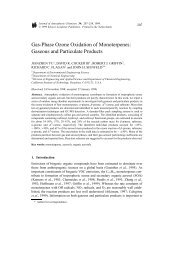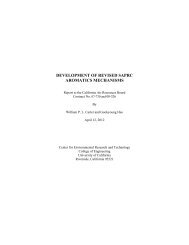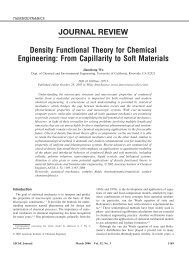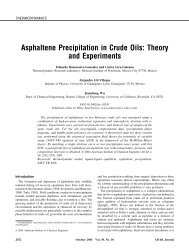A modified fundamental measure theory for spherical particles in ...
A modified fundamental measure theory for spherical particles in ...
A modified fundamental measure theory for spherical particles in ...
You also want an ePaper? Increase the reach of your titles
YUMPU automatically turns print PDFs into web optimized ePapers that Google loves.
J. Chem. Phys., Vol. 119, No. 4, 22 July 2003 Spherical <strong>particles</strong> <strong>in</strong> microchannels<br />
2293<br />
FIG. 4. The density profiles at the midplane of the rectangular channel from<br />
Monte Carlo simulation. Here the l<strong>in</strong>es correspond to the density profiles at<br />
h4.5 and the po<strong>in</strong>ts to those at l7. The rectangular channel is the same<br />
as that shown <strong>in</strong> Fig. 2.<br />
FIG. 5. a Density distributions of hard spheres near the wall of the rectangular<br />
channel calculated from Monte Carlo simulation po<strong>in</strong>ts and from<br />
DFT l<strong>in</strong>es. b Same as a but at the midplane.<br />
from the DFT and from the simulation 13 at x/0.36 and a<br />
reduced bulk density of 0.7016 <strong>in</strong> the hard corrugated channel<br />
<strong>for</strong> /2. In this case, the agreement between the theoretical<br />
prediction and molecular simulation is excellent.<br />
Figure 8 shows an overall local density profile <strong>in</strong> the x – y<br />
plane calculated from the improved FMT. Similar to the distribution<br />
of hard spheres <strong>in</strong> rectangular channels, the density<br />
profile exhibits peaks along the corners and on each side of<br />
the corrugated walls.<br />
The DFT was also used to <strong>in</strong>vestigate the effect of <strong>in</strong>terparticle<br />
association on density distributions. Figure 9 shows<br />
the density profile of a four-sited associat<strong>in</strong>g hard-sphere<br />
fluid at temperature 1/T*8 and bulk density b 3<br />
0.7016 <strong>in</strong> a rectangular channel. Here the reduced temperature<br />
is def<strong>in</strong>ed as T*k B T/, where is the site bond<strong>in</strong>g<br />
energy. In this calculation, the volume parameter K <strong>in</strong> the<br />
SAFT <strong>theory</strong> is set to be 1.484910 4 3 . As <strong>for</strong> the hardsphere<br />
case, the rectangular channel has the dimension of h<br />
9 and l14. In contrast to the density profiles of conf<strong>in</strong>ed<br />
neutral hard spheres as shown <strong>in</strong> Fig. 3, the local number<br />
densities at the corners are much smaller than those near the<br />
walls. The density distribution of associat<strong>in</strong>g hard spheres <strong>in</strong><br />
the channel is determ<strong>in</strong>ed by two compet<strong>in</strong>g effects: association<br />
and excluded volume. Because conf<strong>in</strong>ement restricts the<br />
associations, the <strong>particles</strong> are depleted from the walls or corners.<br />
On the other hand, the excluded volumes of the hard<br />
spheres leads to the accumulation of <strong>particles</strong> near a hard<br />
wall. While the <strong>for</strong>mer takes place only <strong>in</strong> associat<strong>in</strong>g fluids,<br />
the latter appears <strong>in</strong> both neutral and associat<strong>in</strong>g hard<br />
spheres. F<strong>in</strong>ally, Fig. 10 shows the density profiles of foursited<br />
associat<strong>in</strong>g hard spheres near the conf<strong>in</strong><strong>in</strong>g walls. As<br />
expected, the pack<strong>in</strong>g effect dom<strong>in</strong>ates the density distribu-<br />
Downloaded 14 Jul 2003 to 166.111.35.209. Redistribution subject to AIP license or copyright, see http://ojps.aip.org/jcpo/jcpcr.jsp
















